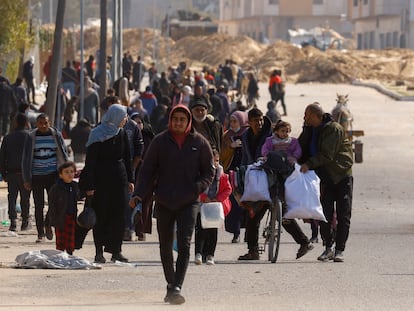Israeli protestors attempt to block aid into Gaza: ‘The enemy is to be killed, not fed’
Demonstrators managed to stop trucks bound for the Strip in the port of Ashdod to press for the release of the hostages still being held after the Hamas attacks of October 7
Protests have been staged in Israel calling for a blockade on the delivery of humanitarian aid to Gaza. Demonstrators openly advocate that depriving Gazans of food and water is a method to apply pressure for the release of the 136 hostages still held in the Palestinian enclave, mainly by Hamas. Some relatives of the hostages have taken part in the protests. The latest march took place Thursday in Ashdod, a port city located about 20 kilometers (12 miles) north of the Strip. Around 200 people cut off two access points to the port’s facilities and blocked the passage of trucks and cars for several hours. “The enemy is to be killed, not fed,” shouted Orit Rosenfelder, 22, who was draped in an Israeli flag expressed his opinion that no one in Gaza is innocent. “All the aid that comes through this port goes to support our enemies, so that they can continue killing us,” he said.
The tone of other attendees was similar to Rosenfelder’s. “We want our government to stop helping terrorists, but it doesn’t have the courage to stop the shipments,” argued Yeshava Kest, 23. Kest claimed that Hamas controls all aid entering the Strip and echoed calls made recently by some members of Benjamin Netanyahu’s coalition government for the expulsion of the Palestinian population from Gaza.
Hundreds of thousands of Palestinians are attempting to survive without the most basic necessities due to the Israeli offensive and the blockade of Gaza, where over 27,000 have died since the war began on October 7, 2023. The international community is applying pressure to prevent Israel from continuing to use starvation as a weapon, but there are indicators that make it clear this tactic of collective punishment is widely supported. Asked whether aid deliveries should be stopped until the hostages are released 72% of respondents said yes, according to a poll conducted this week by Israeli broadcaster Channel 12.
“Helping terrorists, giving them fuel, water, food... so that they continue to kill our people, innocent civilians. To rape women. What is happening here is not happening anywhere in the world, not even in Afghanistan. It’s crazy,” said Kest, who traveled from Jerusalem to Ashdod to take part in the protest.
In a crisis of unprecedented proportions, the vast majority of Gaza’s 2.3 million inhabitants have no access to food and water. They also lack electricity and fuel for generators. Nearly two million Palestinians have been displaced by Israeli bombardments, which have destroyed or damaged some 60% of buildings in the Strip, forcing refugees to seek shelter in makeshift camps of tents in the middle of winter.
In recent days, demonstrations by Israeli right-wing extremist groups have taken place near the Kerem Shalom crossing — which marks the border between Israel and southern Gaza — and the Nitzana crossing between Israel and Egypt. In some cases, the protests succeeded in getting aid trucks to turn back and return to Egypt. But with the international community closely following events, the Israeli army declared the area a military zone, meaning that civilians are prohibited from entering. That is why Thursday’s demonstration took place at the port of Ashdod, where a discreet police presence did not prevent traffic disruptions.
“There is no one innocent in Gaza. If you watch the news, you see that they have ammunition everywhere, in every school, in every house. Everything to kill us. If they want to kill us, the only thing left is to kill them. And, of course, bring back our hostages. The only way to do that is to deny them food. They want food? Give us our hostages. They are feeding them a piece of pita bread a day while we are bringing them 7,500 tons of food every day,” Rosenfelder said.
Protesters in Ashdod waved banners and placards calling on Hamas to release the hostages. According to the authorities there are 136 captives still being held in the Strip, including civilians and military personnel, of whom some 30 are believed to be dead. The demonstrators also chanted slogans demanding the government maintain the intensity of its military operations at a time when the three mediating countries (Qatar, Egypt, and the United States) are attempting to secure a ceasefire agreement between Israel and Hamas, which would include the release of hostages in exchange for Palestinian prisoners held in Israeli jails, and a greater flow of humanitarian aid.
“We must not feed the enemy, especially if he kidnaps our people,” said Yosef Haim, 47. “The first thing is that they free our people and lay down their arms, then we can give them what they ask for,” he added, stating there should be no ceasefire even if it is to engineer the release of the hostages.
Against the backdrop of the protests, the Israeli government is maintaining its campaign against the United Nations agency in charge of caring for Palestinian refugees, UNRWA. Netanyahu’s government links UNRWA to Hamas, due to claims of alleged involvement in the October 7 attacks by 12 local employees of the agency, which has 30,000 employees in Gaza, the West Bank, East Jerusalem, Syria, Lebanon, and Jordan. The UN agency is the main pillar of care for the Strip’s 2.3 million inhabitants and several major donors have stopped providing funds, leading UNRWA to state that it will not be able to continue operating beyond February.
Sign up for our weekly newsletter to get more English-language news coverage from EL PAÍS USA Edition
Tu suscripción se está usando en otro dispositivo
¿Quieres añadir otro usuario a tu suscripción?
Si continúas leyendo en este dispositivo, no se podrá leer en el otro.
FlechaTu suscripción se está usando en otro dispositivo y solo puedes acceder a EL PAÍS desde un dispositivo a la vez.
Si quieres compartir tu cuenta, cambia tu suscripción a la modalidad Premium, así podrás añadir otro usuario. Cada uno accederá con su propia cuenta de email, lo que os permitirá personalizar vuestra experiencia en EL PAÍS.
¿Tienes una suscripción de empresa? Accede aquí para contratar más cuentas.
En el caso de no saber quién está usando tu cuenta, te recomendamos cambiar tu contraseña aquí.
Si decides continuar compartiendo tu cuenta, este mensaje se mostrará en tu dispositivo y en el de la otra persona que está usando tu cuenta de forma indefinida, afectando a tu experiencia de lectura. Puedes consultar aquí los términos y condiciones de la suscripción digital.
More information
Archived In
Últimas noticias
Most viewed
- Sinaloa Cartel war is taking its toll on Los Chapitos
- Oona Chaplin: ‘I told James Cameron that I was living in a treehouse and starting a permaculture project with a friend’
- Reinhard Genzel, Nobel laureate in physics: ‘One-minute videos will never give you the truth’
- Why the price of coffee has skyrocketed: from Brazilian plantations to specialty coffee houses
- Silver prices are going crazy: This is what’s fueling the rally











































